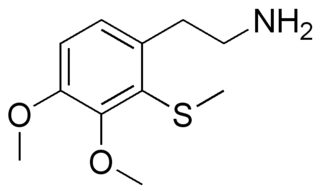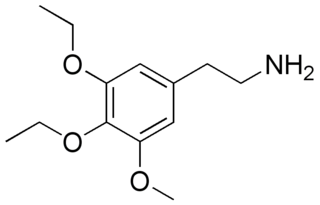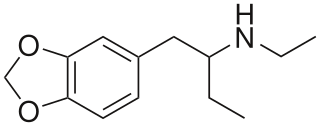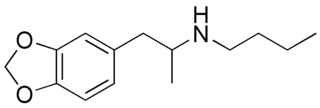Ganesha (2,5-dimethoxy-3,4-dimethylamphetamine) is a lesser-known psychedelic drug. It is also a substituted amphetamine. It was first synthesized by Alexander Shulgin. In his book PiHKAL, the dosage range is listed as 24–32 mg. The drug is usually taken orally, although other routes such as rectally may also be used. Ganesha is synthesized from 2,5-dimethoxy-3,4-dimethylbenzaldehyde. Ganesha is the amphetamine analog of 2C-G. It is a particularly long lasting drug, with the duration listed in PiHKAL as being 18–24 hours, which might make it undesirable to some users. It is named after the Hindu deity, Ganesha. Very little is known about the dangers or toxicity of ganesha. Effects of ganesha include:

Aleph is a psychedelic hallucinogenic drug and a substituted amphetamine of the phenethylamine class of compounds, which can be used as an entheogen. It was first synthesized by Alexander Shulgin, who named it after the first letter of the Hebrew alphabet. In his book PiHKAL, Shulgin lists the dosage range as 5–10 mg, with effects typically lasting for 6 to 8 hours.

3,4-Methylenedioxy-N-hydroxyamphetamine is an entactogen, psychedelic, and stimulant of the phenethylamine and amphetamine chemical classes. It is the N-hydroxy homologue of MDA, and the N-desmethyl homologue of MDHMA. MDOH was first synthesized and assayed by Alexander Shulgin. In his book PiHKAL, Shulgin listed the dosage range as 100–160 mg, and the duration as approximately 3–6 hours. He describes MDOH as being very psychedelic and producing increased pleasure in beauty and nature. He also mentioned several negative side effects also seen with MDMA ("Ecstasy") such as difficulty urinating and internal dryness.

3,4-Methylenedioxy-N-propylamphetamine is a lesser-known psychedelic drug and a substituted amphetamine. MDPR was first synthesized by Alexander Shulgin. In his book PiHKAL, the minimum dosage is listed as 200 mg, and the duration unknown. MDPR is a promoter; by itself it has almost no effects on the mind, but it promotes the effects of hallucinogens, similarly to the closely related MDPH.

TIM, or thioisomescaline, is a series of lesser-known psychedelic drugs similar in structure to mescaline. They were first synthesized by Alexander Shulgin. In his book PiHKAL , none of their durations are known. Very little is known about their dangers or toxicity.

Asymbescaline (3,4-diethoxy-5-methoxyphenethylamine) is a lesser-known psychedelic drug. It is a homolog of mescaline. Asymbescaline was first synthesized by Alexander Shulgin. In his book PiHKAL, the dosage range is listed as 200–280 mg, and the duration listed as 10–15 hours. Asymbescaline produces few to no effects. Very little data exists about the pharmacological properties, metabolism, and toxicity of asymbescaline.
TASB, or thioasymbescaline, is a series of lesser-known psychedelic drugs similar in structure to asymbescaline and to mescaline. They were first synthesized by Alexander Shulgin and written up in his book PiHKAL . Very little is known about their dangers or toxicity.

Buscaline (3,5-dimethoxy-4-butoxyphenethylamine) is a chemical compound prepared as a possible psychedelic drug. It is an analog of mescaline. Buscaline was first synthesized by Alexander Shulgin. In his book PiHKAL, the minimum dosage is listed as 150 mg, and the duration is "several hours". Buscaline produces no psychedelic or psychoactive effects, but causes heart arrythmia and light diarrhea. It does not cause any visuals or insights. Very little data exists about the pharmacological properties, metabolism, and toxicity of buscaline.

3,4-Methylenedioxy-N-hydroxy-N-methylamphetamine is an entactogen, psychedelic, and stimulant of the phenethylamine and amphetamine chemical classes. It is the N-hydroxy homologue of MDMA ("Ecstasy"), and the N-methyl homologue of MDOH. MDHMA was first synthesized and assayed by Alexander Shulgin. In his book PiHKAL, Shulgin listed the dosage range as 100–160 mg, and the duration as approximately 4–8 hours. He describes MDHMA as causing entactogenic and open MDMA-like effects, easing communication, and increasing appreciation of the senses.
Dimethoxyamphetamine (DMA) is a series of six lesser-known psychedelic drugs similar in structure to the three isomers of methoxyamphetamine and six isomers of trimethoxyamphetamine. The isomers are 2,3-DMA, 2,4-DMA, 2,5-DMA, 2,6-DMA, 3,4-DMA, and 3,5-DMA. Three of the isomers were characterized by Alexander Shulgin in his book PiHKAL. Little is known about their dangers or toxicity.

IRIS (2-methoxy-5-ethoxy-4-methylamphetamine) is a lesser-known psychedelic drug and a substituted amphetamine. It is also the 5-ethoxy analog of DOM. IRIS was first synthesized by Alexander Shulgin. In his book PiHKAL, the minimum dosage is listed as 9 mg, and the duration unknown. IRIS produces few to no effects. Very little data exists about the pharmacological properties, metabolism, and toxicity of IRIS.

Ethylbenzodioxolylbutanamine is a lesser-known entactogen, stimulant, and psychedelic. It is the N-ethyl analogue of benzodioxylbutanamine, and also the α-ethyl analogue of methylenedioxyethylamphetamine.

F-2, or 6-(2-aminopropyl)-5-methoxy-2-methyl-2,3-dihydrobenzofuran, is a lesser-known psychedelic drug. F-2 was first synthesized by Alexander Shulgin. In his book PiHKAL, the minimum dosage is listed as 15 mg, and the duration unknown. F-2 produces few to no effects at this dose in humans. Animal studies showed it to substitute for the psychedelic drug DOM, but with less than one tenth the potency.
Thiomescaline (TM) is a pair of lesser-known psychedelic drugs with the molecular formula C11H17NO2S. 3-TM and 4-TM are analogs of mescaline in which an oxygen atom has been replaced with a sulfur atom. They were first synthesized by Alexander Shulgin and described in his book PiHKAL. Very little data exists on the pharmacological properties, metabolism, and toxicity of thiomescaline.
TOM, or methylthio-methyl-methoxyamphetamine, is a series of lesser-known psychedelic drugs and substituted amphetamines with the molecular formula C12H19NOS. 2-TOM and 5-TOM are the 2- and 5-methylthio analogs of 2,5-dimethoxy-4-methylamphetamine (DOM), respectively. They were first synthesized by Alexander Shulgin and described in his book PiHKAL. Very little is known about their dangers or toxicity.

TSB, or thiosymbescaline, is a series of lesser-known psychedelic drugs similar in structure to symbescaline. They were first synthesized by Alexander Shulgin and written up in his book PiHKAL . Very little is known about their dangers or toxicity.

MPM (2,5-dimethoxy-4-propoxyamphetamine) is a lesser-known psychedelic drug and a substituted amphetamine.

Methylenedioxybutylamphetamine is a lesser-known psychedelic drug. It is also the N-butyl derivative of 3,4-methylenedioxyamphetamine (MDA). MDBU was first synthesized by Alexander Shulgin. In his book PiHKAL, the minimum dosage is listed as 40 mg, and the duration unknown. MDBU produces few to no effects. Very little data exists about the pharmacological properties, metabolism, and toxicity of MDBU.

Meta-DOB, or 5-bromo-2,4-dimethoxyamphetamine, is a lesser-known psychedelic drug. It is similar in structure to DOB. Meta-DOB was first synthesized by Alexander Shulgin. In his book PiHKAL , the dosage range is listed as 50–100 mg, and the duration listed as 5–6 hours. Meta-DOB produces few to no effects. Very little data exists about the pharmacological properties, metabolism, and toxicity of Meta-DOB.

Meta-DOT, or 5-methylthio-2,4-dimethoxyamphetamine, is a lesser-known psychedelic drug. It is similar in structure to TMA-2. Meta-DOT was first synthesized by Alexander Shulgin. In his book PiHKAL , the minimum dosage is listed as 35 mg, and the duration unknown. Meta-DOT produces few to no effects. Very little data exists about the pharmacological properties, metabolism, and toxicity of Meta-DOT.
















